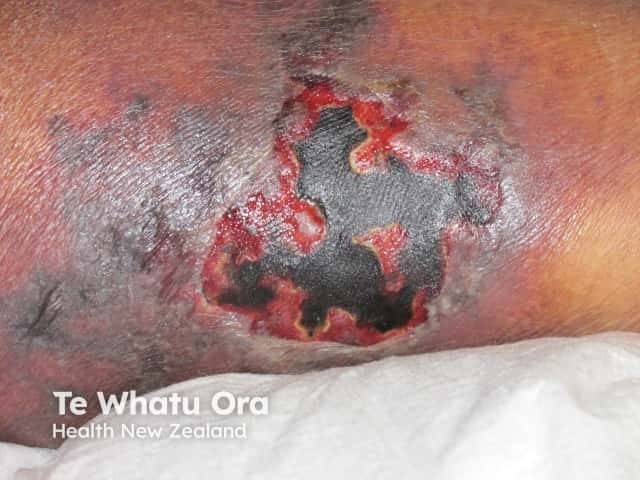Main menu
Common skin conditions

NEWS
Join DermNet PRO
Read more
Quick links
Aeromonas skin infection — extra information
Aeromonas skin infection
Author: A/Prof Amanda Oakley, Dermatologist, Hamilton, New Zealand, April 2014. Copy Editor, Clare Morrison.
What is aeromonas?
Aeromonas is an aquatic bacterium. Aeromonas is a very rare cause of bacterial skin and soft tissue infection. The most common species isolated is Aeromonas hydrophila.
Aeromonas can also cause gastroenteritis (traveller's diarrhoea), meningitis and peritonitis.
What are the signs of aeromonas skin infection?
A. hydrophila can cause severe localised skin infection. It may present as:
- Folliculitis (pustules) and abscesses
- Impetigo-like rash with crusting and erosions that leads to ecthyma gangrenosum
- Cellulitis — redness and swelling involving deeper skin
- Necrotising fasciitis — a rapidly destructive deep soft tissue and muscle infection
- Sepsis (blood-borne infection) — causing fever, fast pulse, malaise and blood count abnormalities (raised white cells, reduced platelets). Aeromonas sepsis is potentially very dangerous
Aeromonas skin infection is more likely to lead to severe complications in patients with weak immune systems, for example those on immunosuppressive medication or being treated for cancer.

Infected leech bites

Necrotising cellulitis
How does infection occur?
A. hydrophila bacteria are found in fresh or salt water such as lakes, rivers, reservoirs, and estuaries, and are more prevalent in warm climates. They may also contaminate moist soil. The bacteria can resist heat, cold and chlorine. Some strains of A. hydrophila produce an aerolysin toxin that causes tissue damage.
Infection occurs when the bacteria that produce aerolysin toxin enter an area of broken skin, such as a shaving cut, abrasion, surgical wound, or insect bite.
Leech bites and medical leech therapy can also lead to A. hydrophila infection, because all leeches carry the bacteria in their gut.
How is the diagnosis of Aeromonas infection made?
The diagnosis of Aeromonas infection may be suspected in a person with a severe infection complicating a minor skin injury that has been exposed to water (or leeches).
In immunocompromised patients, Aeromonas infection is usually diagnosed by laboratory investigation, and infections are often polymicrobial (due to several different kinds of bacteria).
A. hydrophila is isolated by the laboratory from swabs taken from pustules or wound. It is a Gram-negative organism, which means the bacteria appear pink on microscopy using the Gram stain. The organism is identified by culture. Sensitivities should be performed, as some strains of Aeromonas are multidrug resistant.
What is the treatment of Aeromonas infection?
A. hydrophila skin infection is treated with antibiotics such as tetracyclines, sulfonamides, trimethoprim + sulphamethoxazole or ciprofloxacin. It is usually resistant to penicillin.
An Aeromonas abscess is surgically drained. Recovery is followed by scarring with temporary or permanent hair loss.
Patients that are seriously ill should be urgently hospitalised.
References
- Durdu M, Ilkit M. First step in the differential diagnosis of folliculitis: cytology. Crit Rev Microbiol. Feb 2013 Feb;39(1):9–25. doi: 10.3109/1040841X.2012.682051. Epub 2012 May 29. Review. PubMed PMID: 22639852.
- Chao CM, Lai CC, Tang HJ, Ko WC, Hsueh PR. Skin and soft-tissue infections caused by Aeromonas species. Eur J Clin Microbiol Infect Dis. Apr 2013; 32(4):543–7. doi: 10.1007/s10096-012-1771-y. Epub 2012 Nov 8. PubMed PMID: 23135756.
- Giltner CL, Bobenchik AM, Uslan DZ, Deville JG, Humphries RM. Ciprofloxacin-resistant Aeromonas hydrophila cellulitis following leech therapy. J Clin Microbiol. 2013 Apr;51(4):1324–6. doi: 10.1128/JCM.03217-12. Epub 2013 Jan 30. PubMed PMID: 23363826; PubMed Central PMCID: PMC3666766.
- Coutinho AS, de Morais OO, Gomes CM, de Oliveira Carneiro da Motta J. Cutaneous abscess leading to sepsis by Aeromonas hydrophila. Infection. 2013 Apr;41(2):595–6. doi: 10.1007/s15010-012-0337-3. Epub 2012 Sep 28. PubMed PMID: 23055148.
